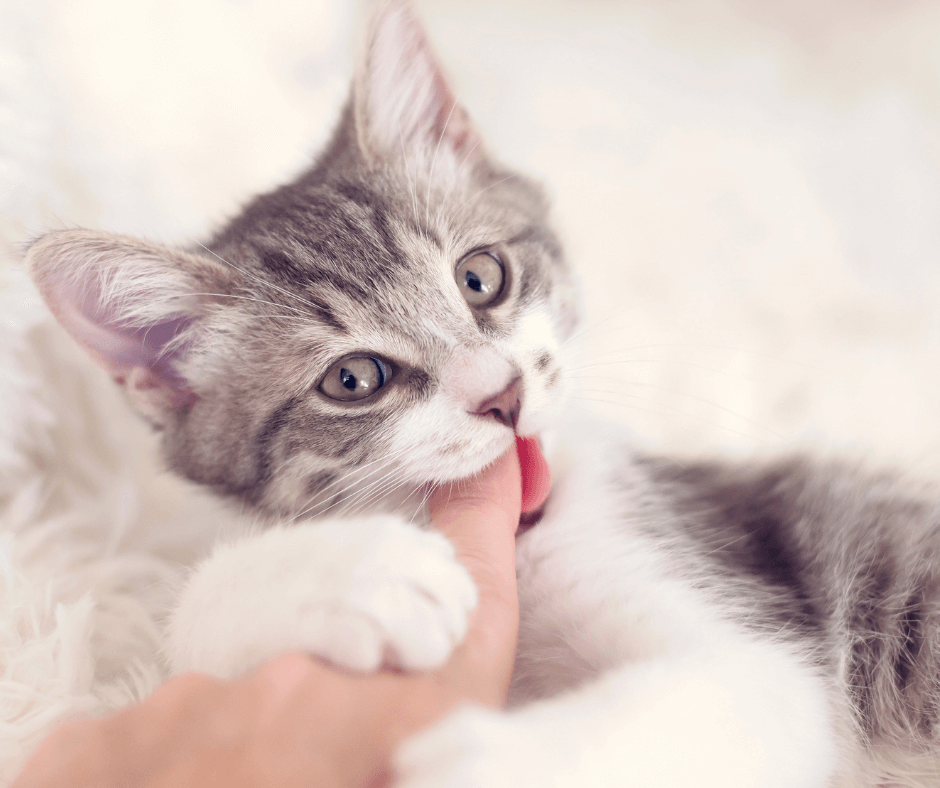Reasons Why Cats Bite

Cats use their mouths and paws to explore their world. It makes sense that biting is part of normal feline behaviour. But we need to determine the motivation behind the bite; gentle play and communication is one thing, but aggressive cat bites must and can be corrected. We take a look at the reasons why cats bite, and how to minimise naughty nipping behaviour.
Play Aggression and Dominance
Biting serves a number of functions for cats. The obvious one is in response to a threat. Biting is also instinctive behaviour to assert dominance. This kind of bite isn’t accompanied by cuddles or goofy cat behaviour.
Shakespeare may as well have been referring to a cat when he wrote: ‘Though she be but little, she is fierce!’ Cats are small, but they can still inflict pain and infection from bites. Warn visitors if your cat is beyond training, as can sometimes be the case for rescue cats. For what is more inviting to a visitor than a fluffy, sleeping cat, only for them to leave, clutching a sore hand wrapped in tissues.
A cat that suddenly jumps out of nowhere to attack the ankles of a passer-by may be amusing and cute, but take it as a sign. Play aggression is a common cat behavioural problem. Look out for aggressive play directed towards people.
Cats love to play. It’s fun for them, but it also satisfies their innate hunting instinct. It does pay to keep in mind how close domestic cats are to their wild cousins. There are breeds and individual cats that portray less of their wild ancestry. But domestication is not an exact science, it’s hasn’t advanced across the board. Remembering this helps a guardian teach their cat not to bite, and to provide them with the physical outlet of play. As cat behaviourist Jackson Galaxy says, ‘Play with your cat, play with your cat, play with your cat!’
The Bite out of Nowhere
The seemingly odd behaviour of the bite out of nowhere makes sense when you understand how sensitive to touch cats are. Unlike dogs, who for the most part could be patted and stroked all day long, cats are very different. A cat may look perfectly relaxed, cuddled up on a warm lap and on the receiving end of gentle stroking. But what is going on under the surface may be surprising.
Cats are highly sensitive to touch. As a kitten grows, how they are handled will generally dictate how they tolerate contact as a mature cat. The more contact a kitten has, the more likely they will embrace it with their guardian as they mature. But cats do vary; some just won’t like it.
Cats do enjoy the body heat and safe presence of their guardian. They love a gentle scratch around the ears and soft stroking of their cheeks. But take care when stroking your cat. Learn their limit. A cat may enjoy it to a point, and because they are safe and warm they may tolerate it a little more. But at breaking point, a mini meltdown can result in a sudden bite and swift exit.
Take heart. A cat may be too sensitive to touch, but will still love curling up beside you and gentle ear scratch. Just go easy on stroking their bodies. Read 9 Ways to Make Your Cat Happy for more ways to keep your kitty content.
Communication
Your cat may also bite as a form of communication. Instead of meowing, some cats will use a nip to signal that they want something from you – to be fed, to open a door, to provide a warm lap to curl up on. The bite won’t be aggressive; it isn’t intended to inflict harm. Try treating the bite as a meow and follow your cat. It may make sense when you are led to their food bowl or a litter box in need of cleaning.
This writer’s cat uses her teeth to redirect pats. Her gentle, toothy hold guides my hand where she would prefer the stroke or scratch.
The Need for Activity
Who can help but marvel at a cat’s ability to jump heights many times their own, flawlessly leaping from one lofty place to another? They are gifted with an amazing skeleton and sensors to aid them assess a situation. Their joints are incredibly flexible, allowing them to stretch and contort at will. Supported by a strong muscular network, cats can control their body to such a degree as to right their bodies mid-air to correct direction, or to ensure they land on their feet. Such an adept body designed for action needs activity.
Cats have quick reflexes and the ability to zone in on movement, as a means of hunting for their next meal or for their protection. They need to exercise this instinct to satisfy the cat lifecycle of hunt, eat, groom, sleep. As cat guardians we can modify this to play, eat, groom, sleep. Cats who are given adequate playtime will become less aggressive.
Another symptom that a cat needs exercise is the zoomies. Guardians may delight in watching their feline zip around the house at speed. It’s not so welcome in the middle of the night. Taking control of the cat lifecycle brings them into a sleep-friendly rhythm. Plus, playtime is another way to strengthen the guardian-cat bond.
How to Stop Biting
Not all older cats respond to correction. The earlier a guardian starts correction the greater the chance of success.
- End play when it becomes too rough. End a play session immediately when a cat or kitten bites too hard. Ending time together and ignoring them is enough to make the point. A cat will soon learn that aggressive behaviour brings an end to playtime. For kittens, this requires patience and consistency.
- Learn your cat’s touch limit. Some cats don’t want to be stroked, others can tolerate it. For sudden biters at cuddle time, learn to enjoy their presence on your lap or by your side without stroking them. Stick to well known happy zones, such as behind the ears and the cheeks. Try laying your arm around them for the cuddle factor.
- Play with your cat. Bear in mind the cat lifecycle of hunt, eat, groom, sleep. Modify it to play, eat, groom, sleep. Because cats are crepuscular, they are instinctively more prone to hunt at dawn and dusk. Playing at these times will increase chances of a positive response, but some cats are ready to play at any time. Cat toys on a stick are essential for obvious reasons. Provide cat toys for independent play. Cat trees often have hanging toys they can bat and play with. Give them your undivided attention in play daily, twice if time permits. Feed after play, and watch them self-groom and curl up for a nap.
- Adopt a second kitten. Adopting another kitten as a playmate works for guardians of kittens who find they are too busy to play every day. Kittens adapt well to added feline company. But for older cats, it may do more harm than good. They are rarely receptive to a new kitten or cat in their space. The bond between guardian and cat still needs time. But the rewards are surely so much more than two-fold.
Biting in cats is normal behaviour. It does have its place, particularly for self defence. Gentle bites can be part of play and sometimes serve as a means to communicate. Sometimes they can’t tolerate any more patting. But bites that hurt or break the skin must be corrected. A cat that is dominant over their guardian is a danger to everyone. Include playtime to meet their activity needs. It serves as an added excuse to spend more time with them. Understanding the domestic cat lifecycle of play, eat, groom, sleep is vital to establishing harmony in the home. At the end of the day, isn’t that what we really want?
